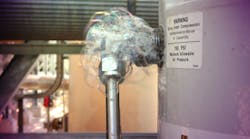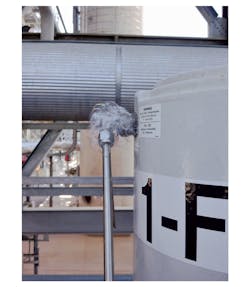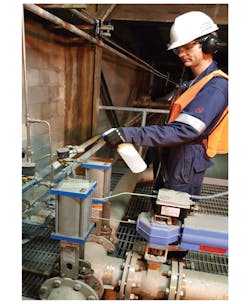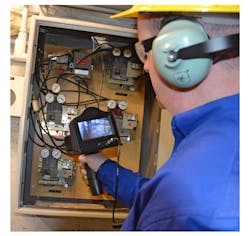Download this article in PDF format.
Content has been updated as of Oct. 20, 2021.
A compressed-air system analysis consists of a complete review of the compressed-air system from the air intake to the end users, plus a compressed-air leak detection and correction program. To achieve success in your compressed-air system analysis, follow these 12 steps:
1. Conduct a walk-through of the entire plant or specific areas to be reviewed. This will single out some of the issues or major areas of concern that demand a higher priority. Pay special attention to areas that require regular human interface, such as quick coupling points, regulators, oilers, drip traps, filters, and areas where plant personnel work. High compressed-air leakage typically occurs in these spots.
2. Set clear goals for the analysis. Examples include:
- Get everyone involved. The most effective programs involve all levels of plant personnel.
- Eliminate the need for one or more air compressors.
- Understand the system’s needs and requirements.
- Determine the air-pressure requirements of the system.
- Benchmark the different components of the system.
- Compare different types of connections. Different types of connections leak at different rates.
- Determine the projected cost of the program and document the (loaded) cost to produce the compressed air.
How many goals are best? Define and document no more than three major objectives or goals to be accomplished during the system analysis. (Example: removing one or more air compressors from operation by increasing the reliability and efficiency of the compressed-air system.) Define and document no more than four minor objectives or goals to be accomplished during the system analysis. (Example: documenting the performance of a component in the compressed-air system.)
This view shows bubbles forming at a suspected leak site. The relatively large size of the bubbles indicates a substantial leak at low pressure.
Sometimes a compressed-air system analysis originates as a request from one area in a facility to overcome a specific problem or issue. Therefore, it may not focus on improving the overall efficiency of the system. Chances of success drop significantly if the facility does not possess all of the required basic information and a clear focus on the goals of the system analysis.
3. Determine which methods will be used to accomplish the goals, and do not institute a program unless personnel are available to complete the task. The first question: Who will perform the work—in-house staff or a third party? Advantages and disadvantages exist for either choice.
In-house—If you do the work in-house, the people involved are more likely to know the compressed-air system. Plus, the analysis will ultimately give plant personnel a greater knowledge of what is happening in the facility. However, some specific skills are required to conduct a proper compressed-air system analysis, and if plant personnel are not completely dedicated to the program, chances are, the analysis will fail.
Also, the equipment needed for a compressed-air system analysis can be expensive, with high-end ultrasound guns costing as much as $15,000 to $20,000. However, detecting and repairing leaks should not be a one-time occurrence. Therefore, the cost of an ultrasonic instrument can pay for itself many times over if used at regular intervals.
Outsourced—Contracting out the analysis to an engineering or compressed-air system analysis firm can ensure a positive outcome. The contracted firm will provide the necessary labor and testing equipment. However, that contracted firm will not know the facility layout or operating conditions. As such, outside compressed-air leak-detection professionals may have a more difficult time defining the locations of leaks. We always recommend assigning someone from your facility to join the outsource team.
In either case, leak-detection analysis is typically the first objective of a facility’s compressed-air-system efficiency improvement program. Once the compressed-air leaks are identified, prioritize them for repair.
4. Sell the program to management to obtain funding for the project. Here are several ways to prepare for your meeting with management:
- Know the cost of compressed-air operation.
- Define the objectives and goals.
- Create a road map on how to accomplish the goals.
- Articulate the expected results of the program.
- Explain how the program will continue.
5. Benchmark the compressed-air system to later determine if the program is a success or failure. This benchmark will also define the roadmap for improving the system. Review the standard operating procedures (SOPs) for the compressor operation. If SOPs do not exist, then institute a program to write them. Without SOPs, the success of the compressed-air program could be jeopardized
6. Determine the equipment or method to be used for leak detection. Any or all of three following options are used most often:
The human ear—This is the most common process for finding leaks, but should be conducted with caution. Many plant environments require hearing protection, which makes this method ineffective. Human hearing is often unable to pinpoint the location of a leak. Furthermore, small leaks may be inaudible even to the sharpest hearing. Yet, every one of these small leaks wastes energy. Adding up the grand total of the many inaudible leaks in a plant may produce a shocking amount of energy wasted annually. For these reasons, an ultrasonic detector is much more effective at locating and quantifying compressed-air leaks.
Spraying a suspected leak area with soapy water can verify the presence and location of a compressed air leak if bubbles continually form at the site. Experienced practitioners can also assess the severity of the leak by examining the size of the bubbles.
Liquids—Liquid detectors are inexpensive and easy to use, but they can be more time consuming than, say, ultrasonic detectors. One benefit to liquid: it can often be purchased in a low-temperature version if leak detection is done outside in colder weather. Another benefit: bubble size can help determine the size of the leak.
Ultrasound—The average human threshold for sensing high-frequency sounds is about 16.5 kHz. Some will not hear signals this high, while others are capable of detecting even higher-pitched sounds. The highest frequency most humans can detect is 20 kHz (20,000 Hz). Airborne ultrasound technology is the solution for sounds at frequencies ranging from 20 through 100 kHz.
7. Prioritize the largest leaks. With a compressed-air leak-detection and correction program, what degree of leakage will be corrected and what degree will not? Obviously, the larger the leak, the more energy it wastes. Some leaks may require lines to be shut down, making it important to determine when this can be done to avoid affecting production.
Once the compressed-air leaks have been fixed, maintenance personnel should remove the tags and return them to the system-analysis coordinator. The tags can then be cross-referenced back to the leak system-analysis sheet to confirm that the repairs were made.
8. Prioritize the areas to be tested based on the following criteria:
- Ease of accessibility
- Highest concentration of equipment
- Ability to document cost savings or production
9. Determine what documentation will be required. The program’s success depends on documenting the compressed-air system and quantifying aspects of the system that require corrective action. Vague reports or documentation will discourage plant personnel and typically lead to program failure. Documentation should identify the location of the leak, the component that is leaking, and the severity of leakage (in cfm, if possible).
10. Find a qualified contractor. Several issues must be addressed when evaluating a contractor for conducting a compressed-air system analysis. Will the analysis be a total system review, or will the system be reviewed in sections? A common area for review is detecting and correcting compressed-air leaks. Companies that mainly conduct compressed-air leak surveys typically do not have full system-analysis capabilities.
When selecting a contractor to conduct a compressed-air system analysis, develop and follow a pre-system analysis checklist of selection objectives and goals. This will help you map out the system-analysis process from beginning to end.
An ultrasonic detection gun is among the most effective methods of pinpointing the location and severity of compressed-air leaks.
Following is a suggested checklist of what to look for with a contracting firm:
- Can the firm do all of the work that you require? Or will you have to hire another company to finish a section of the project?
- Does the firm have a good safety record?
- Has the firm done this type of work before in your sector, and does it have references?
- Does the firm have an ulterior motive for doing the survey? That is, is it trying to sell a new compressor, filter, piping system, or the like?
- Is the firm involved in organizations or groups that work toward energy efficiency?
Assigning someone from your facility to join the system analysis helps ensure that the areas you want to review are covered, and any issues that arise can be dealt with in a timely manner. The person who joins the system-analysis team can also help clarify questions about the system’s operation or procedures. Assigning someone to the team will help ensure that it is operating in a safe manner and not doing anything that may cause a problem or shut down your operation.
When selecting a contractor, be sure to have a clear understanding of the scope of the work, and that your contractor knows what is expected of it. If you have any specific site requirements for training or safety certificates, ensure that the contractor knows and has the appropriate training.
Firm dates should be set for the system analysis and delivery of the report. Try to get the report within a week of the system analysis. That way, any questions or issues that arise will be easier to remember and resolve.
11. Conduct the compressed-air system analysis and make the corrections to the system. Pay particular attention to safety and verification.
How often should you conduct such an analysis? Set up continuing leak inspection by maintenance personnel so that each primary section of the plant is inspected to identify and repair leaks once a month or at least every six weeks. Keep a record of findings and results. Qualify and measure each leak to estimate its flow and assign a measurable cost value to it.
Consider setting up programs where production personnel (particularly operators and supervisors) are positively motivated to identify and repair leaks. Establish and monitor continuing air-conservation programs.
12. Market the program’s results to plant management. This will keep the program top of mind, keep it moving forward, and ensure continuing success.
- Benchmark the system.
- Document the results.
- Calculate the energy savings.
- Determine the improvements in product quality.
- Resolve any issues with equipment.
Kelly Paffel is technical manager at Inveno Engineering LLC, Tampa, Fla. For more information, call (239) 289-3667, or visit www.invenoeng.com.




